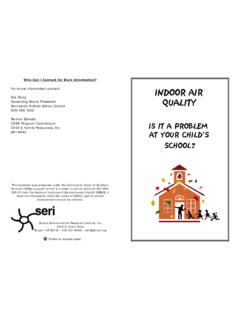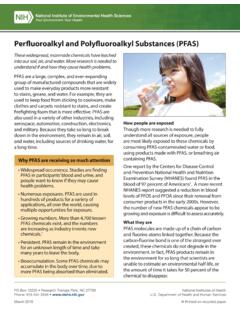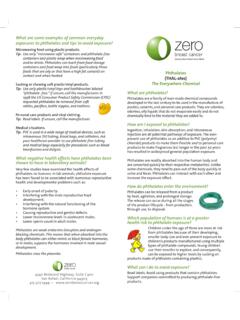Transcription of Flame Retardants Fact Sheet - National Institute of ...
1 Flame RetardantsWhat are Flame Retardants ? Flame Retardants are chemicals that are added or applied to materials in order to slow or prevent the start or growth of fire. Where are Flame Retardants used? Flame Retardants have been used in many consumer and industrial products since the 1970s, to decrease the ability of materials to ignite. Flame Retardants are often added or applied to the following products. Furnishings, such as foam, upholstery, mattresses, carpets, curtains, and fabric and electrical devices, such as computers, laptops, phones, televisions, household appliances, and wires and cables.
2 Building and construction materials, including electrical wires and cables, and insulation materials, such as polystyrene and polyurethane insulation products, such as seats, seat covers and fillings, bumpers, overhead compartments, and other parts of automobiles, airplanes, and Flame Retardants have been removed from the market or are no longer produced. However, because they do not easily break down, they can remain persistent in the environment for years. They can also bioaccumulate, or build up in people and animals over are people exposed to Flame Retardants ?
3 People can be exposed to Flame Retardants through a variety of ways, including diet; consumer products in the home, car, airplane, and workplace; and house These chemicals can get into the air, water, and soil during manufacture. Chemicals can leak from products into dust and into the air. Dust can get on hands and food and then into the mouth when food is eaten. Through e-waste or the uncontrolled burning and dismantling of electronic and electric waste. What are some of the potential health effects associated with Flame Retardants ?
4 Although Flame Retardants can offer benefits when they are added to some products, a growing body of evidence shows that many of these chemicals are associated with adverse health effects in animals and humans, including endocrine and thyroid disruption, impacts to the immune system, reproductive toxicity, cancer, and adverse effects on fetal and child development and neurologic is most vulnerable?Children may be particularly vulnerable to the toxic effects of these chemicals, because their brain and other organs are still developing.
5 Hand-to-mouth behavior and proximity to the floor increases the potential of children to be exposed to Flame Retardants . Researchers have found that children have higher concentrations of Flame Retardants in their bodies than are hundreds of different Flame Retardants . They are often broken into categories based on chemical structure and properties. Brominated Flame Retardants and organophosphorus Flame Retardants are two types of commonly used Flame Retardants . PO Box 12233 Research Triangle Park, NC 27709 Phone: 919-541-3345 2016 National Institutes of Department of health and Human Services Printed on recycled paperNational Institute of environmental health SciencesWhy are NIEHS and NTP studying these chemicals?
6 Flame Retardants are being studied because of their abundance in the environment and concerns about their impact on human health , especially to children who can be easily exposed to them through hand-to-mouth contact. There is growing evidence that many Flame retardant chemicals can affect the endocrine, immune, reproductive, and nervous systems. Some animal studies have shown that long-term exposure to Flame Retardants can lead to cancer. Researchers are also beginning to look at the potential association between Flame Retardants and other health outcomes, including thyroid disruption and obesity, and the role they may be playing in human development.
7 More research needs to be done to understand the effect these chemicals are having on human health . The National Toxicology Program, an interagency testing program headquartered at NIEHS, has received many nominations to study Flame Retardants , because of the lack of information about their toxicity. NIEHS is also interested in conducting research and sharing new findings that will help companies develop safer alternatives to current Flame Retardants . NIEHS needs to better understand how people dispose of products that contain Flame Retardants .
8 For example, at sites where discarded consumer products containing Flame Retardants are dismantled, recycled, or burned, there is potential for release of these products into the air, soil, and water. These chemicals can then be absorbed by surrounding vegetation, animals, or NIEHS Superfund researchers and others are working to find better solutions to reduce exposure to e-waste that will not harm people or the there different types of Flame Retardants ? What do we know about them?There are hundreds of different Flame Retardants .
9 They are often broken into categories based on chemical structure and properties. In general, Flame Retardants are grouped based on whether they contain bromine, chlorine, phosphorus, nitrogen, metals, or Flame Retardants . These chemicals contain bromine and are the most abundantly used Flame Retardants . They are used in many types of consumer goods, including electronics, furniture, building materials, and automobiles, to slow or prevent the start or growth of fire. Brominated Flame Retardants have been shown to have many effects on the body, including disruption of the endocrine Polybrominated diphenyl ethers (PBDE s).
10 This group of industrial chemicals was added to consumer products to meet flammability standards in the 1970s, after another similar product, polybrominated biphenyls, was taken off the market. PBDEs do not chemically bind to the products to which they are added, such as furniture and electronics, so they easily release from these products and get into air and dust. They can also enter the environment through manufacturing, wearing down of products during use, and product disposal. Researchers have found that PBDEs can lower birth weight and length of children, and impair neurological In animal studies conducted by NTP, several PBDEs have been shown to cause ,8 While PBDEs have been banned or phased out of production, they still remain persistent in the Institute of environmental health sciences Tetrabromobisphenol A (TBBPA).











